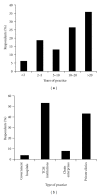Knowledge, attitude, and practice of dry eye treatment by institutional Chinese physicians in Singapore
- PMID: 23213306
- PMCID: PMC3504406
- DOI: 10.1100/2012/923059
Knowledge, attitude, and practice of dry eye treatment by institutional Chinese physicians in Singapore
Abstract
Dry eye is a common health problem worldwide, causing significant discomfort and inconvenience to sufferers. The conventional treatment of dry eye via topical administration of eye drops is deemed palliative and unsatisfactory to many. Traditional Chinese medicine (TCM) has shown some promise in dry eye treatment; however, the extent of its use and acceptance is uncertain. We evaluated the knowledge, attitude, and practice of institutional TCM practitioners in the treatment of dry eye in Singapore. A questionnaire was generated to address the study aims and sent to TCM practitioners listed in the Singapore TCM practitioners' board database. About three quarters of respondents thought that dry eye was not severe enough to be a public health burden but most thought that TCM was effective in the treatment of dry eye. Acupuncture and herbal medicine were most commonly used TCM modalities in dry eye treatment, and a single TCM treatment session would be charged S$20-50 by the practitioner. The majority of surveyed institutional TCM practitioners in Singapore believe that TCM is relevant in dry eye treatment. Public awareness should be raised regarding the availability of TCM as alternative medicine for dry eye.
Figures




Similar articles
-
Dry Eye Disease Practice in Ghana: Diagnostic Perspectives, Treatment Modalities, and Challenges.Optom Vis Sci. 2020 Mar;97(3):137-144. doi: 10.1097/OPX.0000000000001487. Optom Vis Sci. 2020. PMID: 32168235
-
Survey of eye practitioners' preference of diagnostic tests and treatment modalities for dry eye in Ghana.Cont Lens Anterior Eye. 2016 Dec;39(6):411-415. doi: 10.1016/j.clae.2016.08.001. Epub 2016 Aug 6. Cont Lens Anterior Eye. 2016. PMID: 27507732
-
Survey of eye practitioners' attitudes towards diagnostic tests and therapies for dry eye disease.Clin Exp Ophthalmol. 2005 Aug;33(4):351-5. doi: 10.1111/j.1442-9071.2005.01026.x. Clin Exp Ophthalmol. 2005. PMID: 16033344
-
A survey on treatment of dry eye by traditional chinese medicine and integrative chinese and Western medicine.Chin J Integr Med. 2006 Jun;12(2):154-9. doi: 10.1007/BF02857366. Chin J Integr Med. 2006. PMID: 16800999 Review.
-
Management of dry eye disease to optimize cataract surgery outcomes: Two tables for a daily clinical practice.J Fr Ophtalmol. 2019 Oct;42(8):907-912. doi: 10.1016/j.jfo.2019.03.032. Epub 2019 Jul 24. J Fr Ophtalmol. 2019. PMID: 31351686 Review.
Cited by
-
Acupuncture and herbal formulation compared with artificial tears alone: evaluation of dry eye symptoms and associated tests in randomised clinical trial.BMJ Open Ophthalmol. 2018 Jun 18;3(1):e000150. doi: 10.1136/bmjophth-2018-000150. eCollection 2018. BMJ Open Ophthalmol. 2018. PMID: 30123846 Free PMC article.
-
Coping with dry eyes: a qualitative approach.BMC Ophthalmol. 2018 Jan 16;18(1):8. doi: 10.1186/s12886-018-0671-z. BMC Ophthalmol. 2018. PMID: 29338780 Free PMC article.
-
The effectiveness and safety of moxibustion for dry eye: Protocol for a systematic review.Medicine (Baltimore). 2019 Apr;98(15):e15178. doi: 10.1097/MD.0000000000015178. Medicine (Baltimore). 2019. PMID: 30985705 Free PMC article.
-
Fourier-domain optical coherence tomography for monitoring the lower tear meniscus in dry eye after acupuncture treatment.Evid Based Complement Alternat Med. 2015;2015:492150. doi: 10.1155/2015/492150. Epub 2015 Feb 18. Evid Based Complement Alternat Med. 2015. PMID: 25788963 Free PMC article.
-
A systematic literature review for evaluation of knowledge, attitude, and self-care practice regarding common eye diseases in the healthy general population.J Family Med Prim Care. 2024 Feb;13(2):417-424. doi: 10.4103/jfmpc.jfmpc_1295_23. Epub 2024 Mar 6. J Family Med Prim Care. 2024. PMID: 38605788 Free PMC article. Review.
References
-
- Moss SE, Klein R, Klein BE. Prevalance of and risk factors for dry eye syndrome. Archives of Ophthalmology. 2000;118(9):1264–1268. - PubMed
-
- Patel VD, Watanabe JH, Strauss JA, Dubey AT. Work productivity loss in patients with dry eye disease: an online survey. Current Medical Research and Opinion. 2011;27(5):1041–1048. - PubMed
-
- Pflugfelder SC. Prevalence, burden, and pharmacoeconomics of dry eye disease. The American Journal of Managed Care. 2008;14(supplement 3):S102–S106. - PubMed
-
- Smith JA. The epidemiology of dry eye disease: report of the epidemiology subcommittee of the international dry eye workshop. Ocular Surface. 2007;5(2):93–107. - PubMed
-
- Apostol S, Filip M, Dragne C, Filip A. Dry eye syndrome: etiological and therapeutic aspects. Oftalmologia. 2003;59(4):28–31. - PubMed
Publication types
MeSH terms
LinkOut - more resources
Full Text Sources

